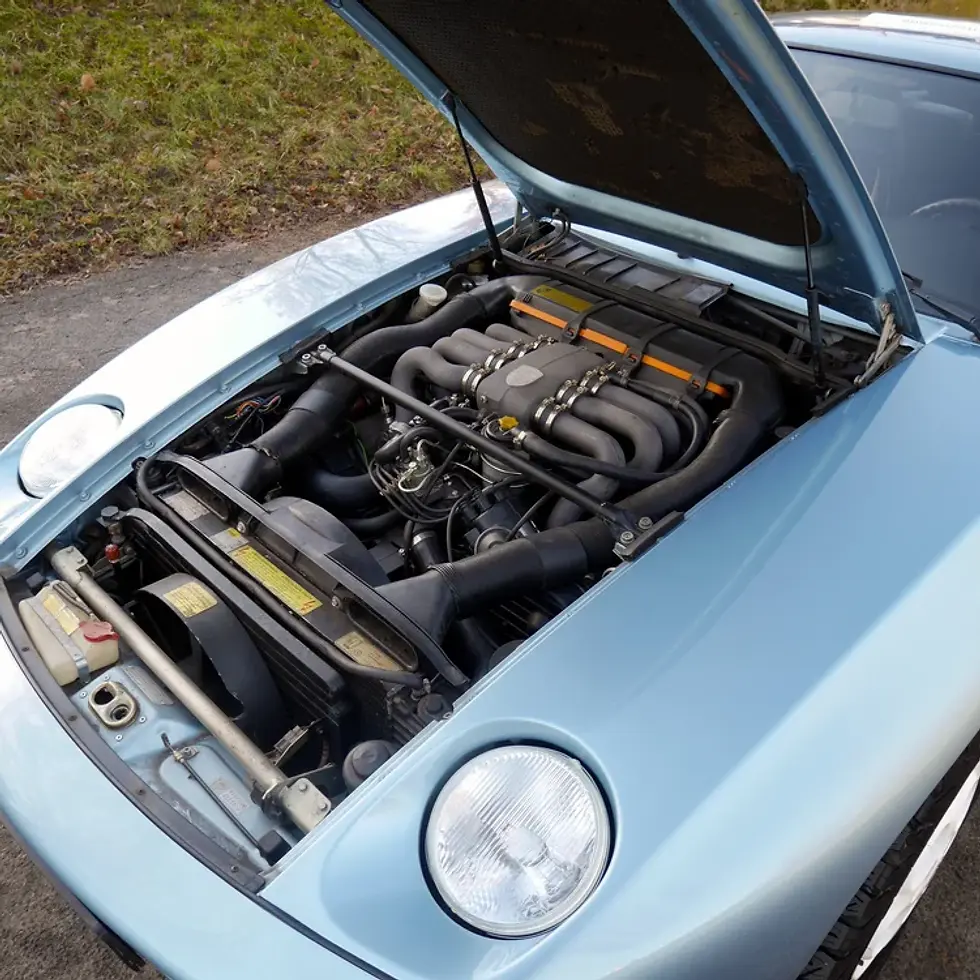Chassis number 2177 GT is a particularly rare example of the Ferrari 250 GT Short Wheelbase. Its frame was sent to Carrozzeria Scaglietti in Modena on 6 September 1960 so that it could receive its hand crafted special order steel bodywork. The competition specification V12 engine – numero interno 612F – was completed on 25 October and it was dyno-tested two days later. The results are noted in the car’s build sheet and show that it produced an impressive 281bhp at 7500rpm.
2177 GT was an unusual steel bodied Competizione model. In that respect, it shares characteristics with 1993 GT and 1995 GT, which were the first two Short Wheelbases to be exported to the UK for British distributor Maranello Concessionaires. The late Richard Colton – the long-term owner of 1995 GT – used to take exception to anyone referring to his car as a Lusso. The history file for 2177 GT includes copies of letters from Colton in which he refers to it as being, in effect, a steel-bodied Competizione in the manner of 1993 GT and 1995 GT. I understand that possibly the Colton car is semi comp engine as per the H & H Catalogue description
The engine therefore featured the high-lift Tipo 130 camshafts, lightweight con-rods and a 9.4:1 compression ratio, while its Weber 40 DCL carburettors had 32mm chokes. The car was also fitted with stiffer springs front and rear, the Competizione ribbed gearbox, a competition exhaust and brackets to accept a quick-lift jack. The window surrounds are in alloy and every conceivable comp feature was originally specified.
The rear axle ratio of 8/32 was well-suited to hillclimb use, and 2177 GT was delivered new on 29 October 1960 to its first owner – a Mr Zimmerman in Switzerland. The supplying dealership was Italauto SA, which was based in Lausanne and was owned by Emmanuel ‘Toulo’ de Graffenried – a former racing driver who won the 1949 British Grand Prix. It’s said that the Swiss hillclimb fraternity preferred the steel body because it was stiffer, harder-wearing and easier to repair than aluminium.
Zimmerman kept 2177 GT until 1962, when he sold it to Armand Boller. Geneva-based Boller was a banker and gentleman racer, and entered the Short Wheelbase for the famous Ollon-Villars hillclimb on 25 August. The event was a round of that year’s European Mountain Championship and attracted a strong field, and Boller finished an impressive fifth in class.
In early 1963, Boller acquired a 250 GTO and would go on to race his latest Ferrari under the banner of Scuderia Filipinetti. Georges Filipinetti was a key figure on the European Ferrari scene at that time, and his competition cars were driven by the likes of Herbert Müller and future Formula 1 star Jo Siffert. Boller was part of that tight-knit group and it’s thought that Siffert might have had at least one outing in 2177 GT in a Swiss event, but so far it has not been possible to prove this theory, he is however mentioned in the Ferrari service sheet.
After Boller bought the GTO, his Short Wheelbase was sold to another Swiss racing driver – Walter Ringgenberg. A Ferrari enthusiast who had previously owned an alloy-bodied 250 GT Short Wheelbase Competizione (1771 GT) as well as a 250 GT ‘Tour de France’, Ringgenberg was a hotelier and restaurateur from Bern. A personal friend of Ferry Porsche, he had raced a 356 during 1953 and ’54 before moving up to a Porsche 550 for 1955. On 18 March that year, he and works driver Richard von Frankenberg used the new car to set six international 1500cc class records at Montlhéry near Paris, and in June Ringgenberg shared it at Le Mans with Hans-Jörg Gilomen.
By the time he bought 2177 GT, Ringgenberg had mostly given up circuit racing preferring hillclimb events, and he entered 2177GT in three events during 1964. In May, he finished third in class at Mitholz-Kandersteg, and went one better at Sierre-Crans-Montana in August. That event was part of the International Championship for GT Manufacturers, in which the GTO was being pushed every inch of the way by the Shelby Cobra, and it therefore attracted a strong entry. Pierre Sudan won the 3-litre class in his GTO with a two-run aggregate time of 15 minutes 6.8 seconds, but second was Ringgenberg, who posted 15 minutes 40.4 seconds in 2177 GT. It was a superb result in such a high-profile hillclimb.
Ringgenberg ended his season with an appearance at Eigental, and in 1966 he sold the Short Wheelbase to a new owner in the US, racing driver, entrepreneur and car dealer Bob Grossman via the Swiss dealership owned by Paul Blancpain and Jo Siffert.
Having grown up in Philadelphia, Grossman settled in Nyack, New York after serving in World War Two. He was a talented singer who used to pay for singing lessons by buying and selling cars – something that soon became his main business.
He acquired a Jaguar dealership via Max Hoffman and got into racing with an XK 120 in Sports Car Club of America events. It was via Jaguar that he got to know Briggs Cunningham, and Grossman would race Lister-Jaguars as well as Lightweight E-types with the renowned American privateer.
He also established a close relationship with Luigi Chinetti and over the years would gain considerable experience with various Ferraris, from an alloy bodied 250 GT California Spyder which he raced to fifth place overall at Le Mans to Short Wheelbases and GTOs. In 1963, Grossman had been elected as president of the Road Racing Drivers Club, an elite group that included a number of the most highly skilled sports car drivers in the United States, and the following year he took a Ferrari GTO (5573 GT) to ninth place overall at Le Mans with team-mate Fernand Tavano.
According to Ferrari historian Marcel Massini, Grossman raced 2177 GT at the Mount Equinox hillclimb in 1966 and after spending some time in the Grossman fleet the car was sold on to fellow racing driver and Ferrari customer from Massachusetts Dudley Cunningham the following year to sit alongside the ex-works Ferrari 340 MM (0322AM) in which talented Marzotto brothers finished fifth overall at Le Mans in 1953.
Cunningham kept 2177GT until 1975 racing it in SCCA events during the early years of his ownership. He sold it – via an advert that claimed it to be ‘ex-Jo Siffert’ – to the Ferrari historian and author Jim Riff, who was based in Illinois. He set about having 2177 GT restored. The process included an engine rebuild, and stripping the Ferrari to bare metal, which showed a remarkable lack of accident damage for a car that had been used in competition. When it was finished, 2177 GT finished second in class at the Ferrari Club of America’s concours in St Louis, having been driven there from Chicago by Jim in the pouring rain!
During Riff’s ownership, the Short Wheelbase was often entered for concours events, and in 1985 he also raced it in a historic event at Elkhart Lake. That same year, 2177 GT appeared on the cover of Ken Gross’s book Ferrari 250 GT SWB, which was published by Osprey.
Riff sold the car in 1986 to California based Tom Byrnes, who raced it in the Monterey Historics weekend at Laguna Seca in 1987 and 1989. Its next custodians were Phillipe Brecht and then Martin Van Doorne, who had the Short Wheelbase restored in 1994-95. Van Doorne later displayed 2177 GT at Ferrari’s 50th anniversary event in Rome and Maranello, before selling it to Geneva-based watchmaker and co-founder of the Swiss Ferrari Club Dr Peter Baumberger.
In 1999, the car was acquired by Austrian Jean-Robert Grellet. Grellet had it repainted yellow and went on to enter the car regularly for events such as the Ennstal Classic, the Giro di Sicilia Revival Targa Florio and the Grand Prix Montreaux. Ferrari also invited 2177 GT to be part of its 70th anniversary celebrations at its Fiorano test track.
Thanks to its incredible versatility as a competition car that can also be driven comfortably on the road, there are those who covet the Short Wheelbase above even the GTO. It certainly continued the level of motorsport success that enthusiasts had come to expect from the 250 GT series. With its Swiss competition history, its rare specification and its fascinating cast of characters, 2177 GT was very much part of this legendary period in Ferrari history.





































































